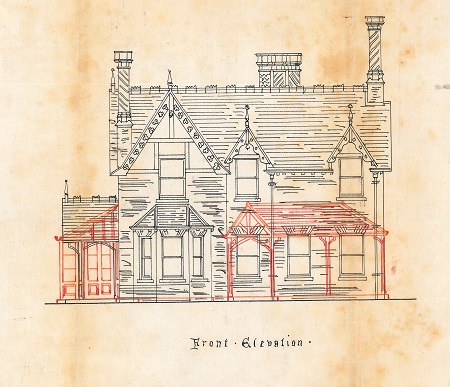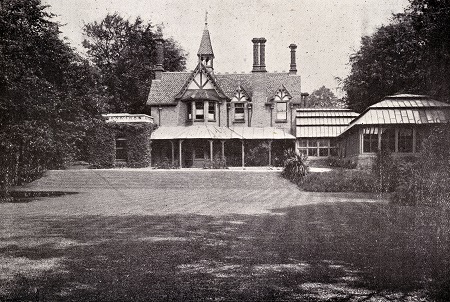The Plantation

Front elevation of The Plantation, 1870 [ref: BorBP258]
The Plantation was a large Victorian house, built for London auctioneer Edward Manson in 1870 [ref: BorBP258]. At the time the plans were drawn up its address was “The Oval, Bromham Road,” the area that now forms the park at the centre of Linden Road and Dynevor Road. The name of the house appears to have been borrowed from the very site on which it stood; an oval area surrounded by trees in an as yet largely undeveloped part of Bedford. The house was later altered between 1877 and 1881 to include a hall, room for storing china, and a dining room. [ref:BorBP652]
Edward Manson was born in Westminster in 1806 and had an older brother William, born in 1800. They were the sons of John Manson, a bookseller and his wife Elizabeth. It seems that John died young aged 38 in 1816 but it doesn’t seem to have harmed the brothers prospects.
In 1831, William joined a firm of auctioneers and became a partner, adding his name to the company’s title, Christie & Manson, later known more famously as Christie’s. When William died in 1852, Edward took over his brother’s role and became partner. In 1859 Thomas H Woods joined as a partner and the firm became known as Christie, Manson & Woods.
In 1828 William Manson married Sarah Graves in London. By 1831 the young couple had much to look forward to, with William becoming a partner at Christie’s and starting a family as Sarah was pregnant. Sadly, tragedy struck as soon after Sarah gave birth to twin daughters, Louisa Sarah and Edith on 13 December 1831, she died. Her funeral took place on Boxing Day 1831 at Kensal Green Cemetery. In 1840 he remarried to Adelaide Norton, and they had two more daughters (Adelaide 1841-1841 and Amy, 1844-1931). William died in 1852 and was laid to rest with his first wife at Kensal Green.
Edward eventually married in 1857 at the age of 50 to Jane Emery, a woman from Kempston Hardwick in Bedfordshire, which is where Edward’s connection to Bedfordshire begins. In 1869, the electoral registers show that he qualified to vote in the area due to owning a house and land at Kempston Hardwick, most likely through an inheritance of his wife’s. From 1873 to 1875 he qualified due to ownership of a freehold garden in Ashburnham Place. However, it seems that The Plantation, despite being built in around 1870, was a country residence for Edward and Jane, as his address in the electoral registers is given as 12 York Terrace, Regents Park, London. By the census of 1881, Edward was a widower, Jane having died the month before the census was taken and his duty of care to his nieces meant that they were now living with him and acting as housekeepers. In 1885 Edward died and left his estate to his unmarried nieces. Louisa and Edith remained at the house until their deaths, Louisa in 1899 and Edith in 1920. Being an auctioneer at Christie’s was obviously a very lucrative career; Edward’s estate in 1885 was valued at £55,983. Being financially secure for the rest of their days, the Misses Manson became active members of local Bedford society and Louisa’s obituary published on the 5th January 1900 in the Bedfordshire Times details the many organisations in which she played a part. Louisa was a member of St Martin’s Church, Bedford and was involved in the running of the mothers’ meetings.
Edith lived for another 20 years and died in March 1920. Both Edith and Louisa were buried at Kensal Green Cemetery with their parents and step-mother. G.C. Walker & Co. the local auctioneers were instructed to handle the sale by her executors and an advertisement was placed in the Bedfordshire Times and Independent on the 25th June 1920 describing the property as an “Exceptionally valuable and tastefully designed residence.” The property stood in grounds of over an acre in size and contained 4 reception rooms, 6 bedrooms, stables, garage, a conservatory, croquet lawn, and both flower and vegetable gardens.
 The Plantation in 1920, South front view[ref: X67/322]
The Plantation in 1920, South front view[ref: X67/322]
By 1923, a Joseph Mercer and his family, wife Maude and four children, Freda, Mona, Roy and Dennis were living at The Plantation (now listed as 1 Linden Road in local directories). Mr Mercer was a businessman who owned several newsagency companies. He was originally from Cheshire, where he married his wife Maude Catherine Halsall in 1907. He is listed in the electoral registers at 1 Linden Road from 1923 to 1935 but then appears to have moved to other properties, having both homes in Whipsnade and in Harpenden. He died at his house in Whipsnade in 1945.
A report of the theft of the lead from the house roof from the Beds Times of May 1938 states that Mr Mercer had left the property empty for three or four years by that time. In a curious turn of events, which local people at the time couldn’t explain, The Plantation was left empty, remained unsold and fell into disrepair and was eventually demolished according to a brief piece in the Beds Times newspaper publish on the 22nd October 1943. The site became wild and something of an eyesore, according to the 1943 article. Why didn’t Mr Mercer sell it or maintain it? There can have been little benefit in letting such a formerly fine house fall into decay but it seems to have happened. An outline application was made and approved in 1951 to build a Presbyterian church hall on the site [ref: BorBTP/51/22], but this was never completed.